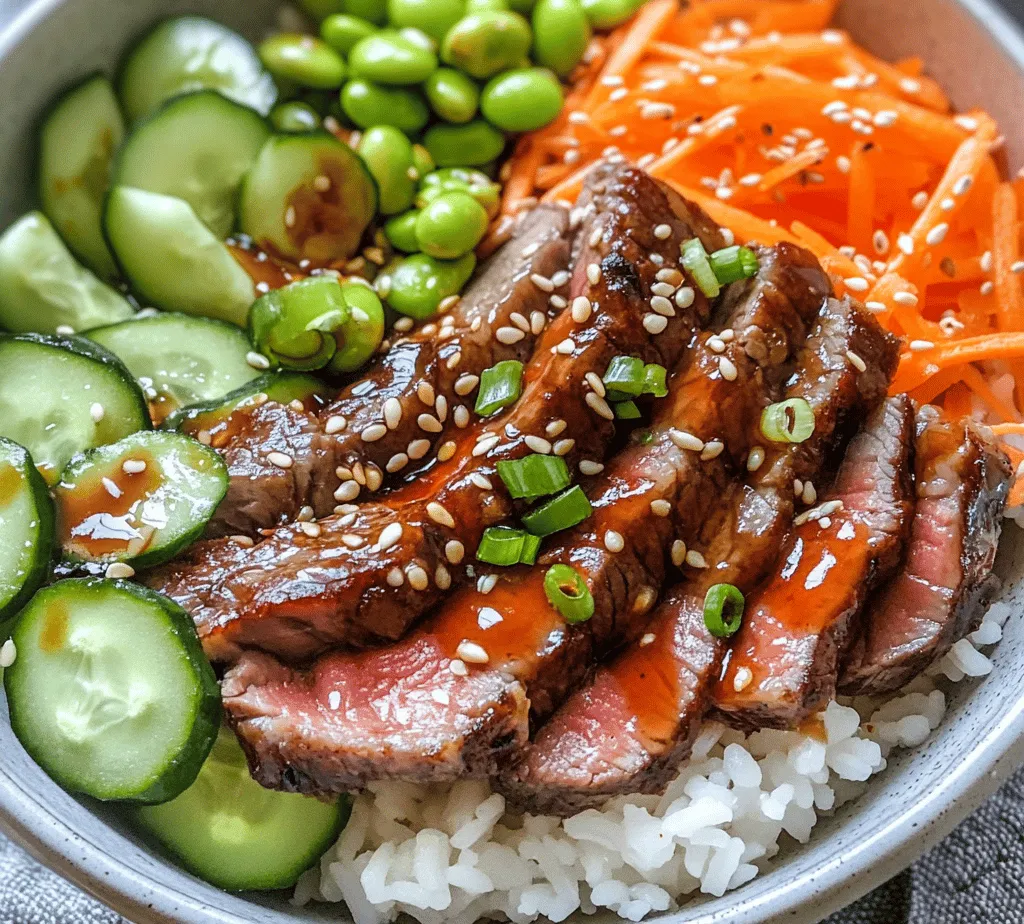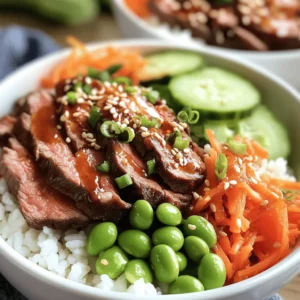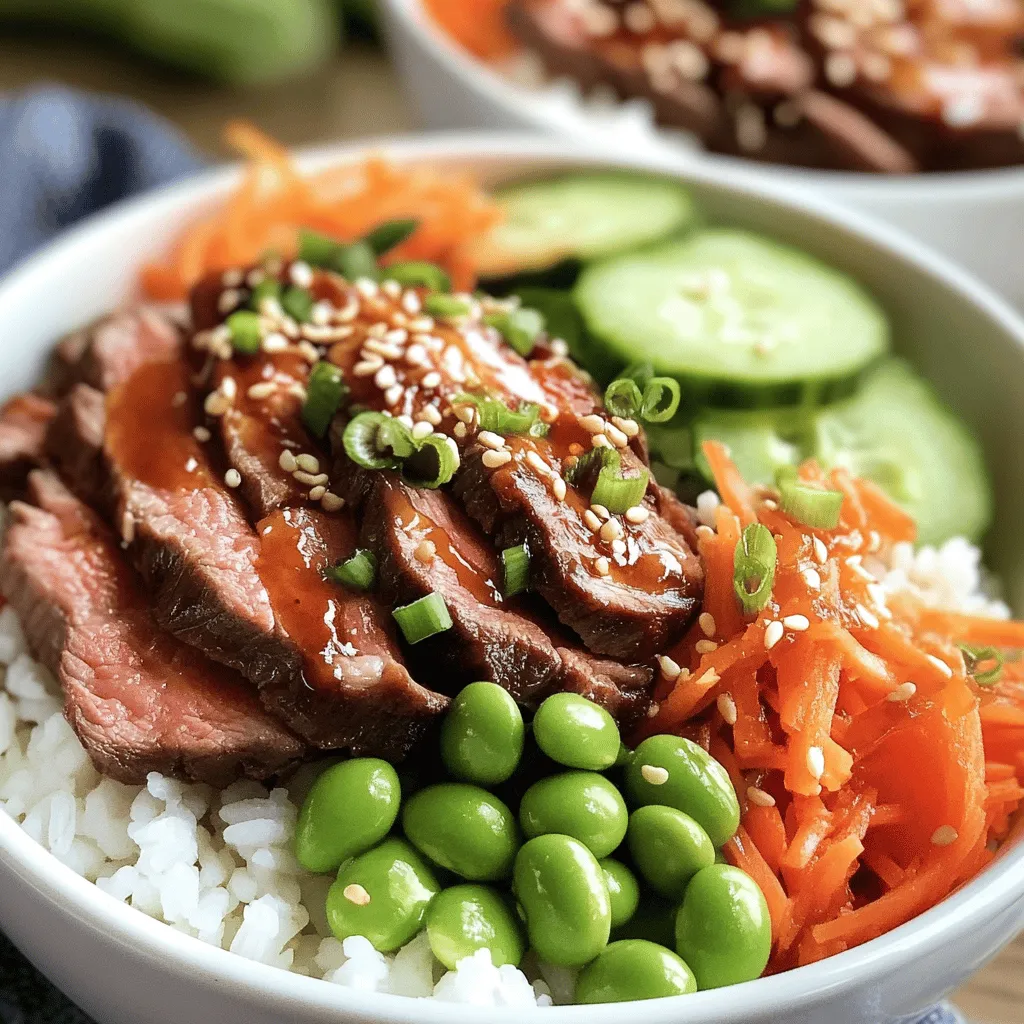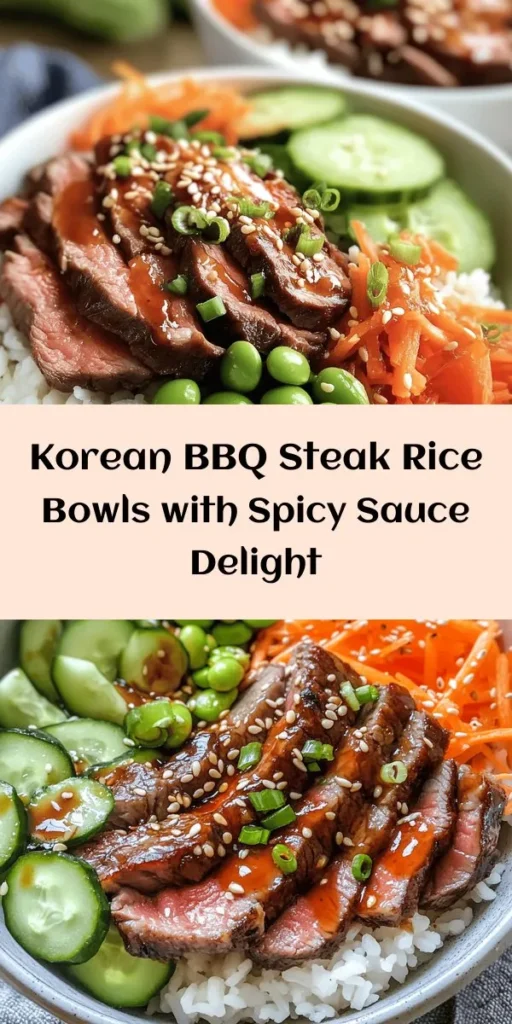Introduction
Korean cuisine has taken the culinary world by storm over the past few years, captivating food enthusiasts with its bold flavors, colorful presentations, and unique combinations of textures. This vibrant cuisine is not just about satisfying one’s hunger; it’s an experience that engages the senses. Among the many delightful dishes that Korean cuisine has to offer, Korean BBQ Steak Rice Bowls stand out as a perfect fusion of flavors and textures, making them a must-try for anyone looking to explore the richness of this culinary tradition.
Korean BBQ Steak Rice Bowls are more than just a meal; they are a celebration of ingredients that come together harmoniously to create a satisfying and delicious dish. The combination of marinated steak, fluffy rice, and crisp vegetables results in a bowl that is not only visually appealing but also bursting with flavor. What’s more, this dish is incredibly versatile—you can easily customize it to suit your taste preferences, whether you prefer extra spice, different vegetables, or a variety of grains.
One of the most appealing aspects of Korean BBQ Steak Rice Bowls is their quick preparation time, making them perfect for busy weeknights or casual gatherings. With vibrant ingredients and an array of flavors, these bowls provide a delightful dining experience that’s sure to impress family and friends alike. In this article, we will take you through the complete process of creating your very own Korean BBQ Steak Rice Bowls, complete with a spicy cream sauce that elevates the dish to new heights.
Understanding the Core Ingredients
To create a truly authentic and flavorful Korean BBQ Steak Rice Bowl, understanding the core ingredients is essential. Each component contributes to the overall taste and experience of the dish, and selecting high-quality ingredients is key to achieving the best results.
Steak
The star of this recipe is undoubtedly the steak, and for this dish, flank or sirloin steak are excellent choices. Both cuts are known for their rich flavor and tenderness when properly cooked. Flank steak, with its long grain and slightly chewy texture, is particularly well-suited for marinating, as it absorbs flavors beautifully. On the other hand, sirloin steak offers a juicy and flavorful bite, making it another popular option for grilling. Regardless of your choice, it’s essential to slice the steak against the grain after cooking to ensure a tender bite.
Gochujang
No Korean dish is complete without gochujang, a staple in Korean cuisine that adds depth and complexity to any recipe. This fermented red chili paste is made from chili powder, glutinous rice, fermented soybeans, and salt, resulting in a unique flavor profile that combines sweetness, spiciness, and umami. Gochujang not only enhances the flavor of the steak marinade but also plays a crucial role in the spicy cream sauce. Its versatility makes it a fantastic ingredient to keep in your pantry, as it can be used in various dishes, from soups to marinades and sauces.
Rice
Serving as the base for the rice bowls, rice is a crucial component that brings everything together. While traditional short-grain white rice is commonly used in Korean cuisine, you can opt for brown rice, jasmine rice, or even quinoa for a healthier alternative. The choice of rice adds a different texture and flavor to the dish, allowing you to tailor the bowls to your liking.
Fresh Vegetables
In addition to the main ingredients, fresh vegetables play a vital role in adding color, crunch, and nutrition to your Korean BBQ Steak Rice Bowls. Common options include shredded carrots, cucumber slices, and sautéed bok choy or spinach. These vegetables not only provide a refreshing contrast to the richness of the marinated steak but also contribute essential vitamins and minerals to the meal.
The Marination Process
To achieve the perfect flavor in your Korean BBQ Steak Rice Bowls, marinating the steak is an essential step that should not be overlooked. The marinade not only infuses the meat with flavor but also helps to tenderize it, resulting in a juicy and succulent steak.
Marinade Ingredients
The marinade for the steak typically includes the following ingredients:
– Soy Sauce: Adds a savory umami flavor and saltiness.
– Gochujang: Provides heat and depth to the marinade.
– Sesame Oil: Contributes a nutty aroma and flavor.
– Garlic: Adds a pungent and aromatic quality that enhances the overall taste.
– Brown Sugar: Balances the saltiness and heat with a touch of sweetness.
– Rice Vinegar or Lime Juice: Provides acidity that helps to tenderize the meat and brighten the flavors.
Step-by-Step Marination Process
1. Prepare the Marinade: In a medium-sized bowl, combine soy sauce, gochujang, sesame oil, minced garlic, brown sugar, and rice vinegar or lime juice. Whisk the ingredients together until the sugar is dissolved and the marinade is well-combined.
2. Marinate the Steak: Place the flank or sirloin steak in a resealable plastic bag or a shallow dish. Pour the marinade over the steak, ensuring it is evenly coated. Seal the bag or cover the dish with plastic wrap.
3. Marination Time: Allow the steak to marinate in the refrigerator for at least 30 minutes. For optimal flavor infusion, aim for 2 to 4 hours of marination. If you have time, marinating overnight will yield even better results, as the flavors will penetrate deeper into the meat.
4. Remove and Rest: After marination, remove the steak from the marinade and let it rest at room temperature for about 15-20 minutes before cooking. This step helps the steak cook more evenly.
Tips for Marinating
– Avoid Over-Marinating: While marinating is essential for flavor, avoid leaving the steak in the marinade for too long (over 12 hours) as the acid can start to break down the meat, resulting in a mushy texture.
– Reserve Some Marinade: If you want to use the leftover marinade as a sauce, be sure to set some aside before adding the raw steak to avoid cross-contamination. You can simmer it down for a delicious drizzle over your finished rice bowls.
Marinating the steak is a simple yet impactful step that sets the foundation for the bold flavors of your Korean BBQ Steak Rice Bowls. The combination of the marinade ingredients works synergistically to create a mouthwatering dish that will leave your taste buds dancing.
Crafting the Spicy Cream Sauce
To elevate your Korean BBQ Steak Rice Bowls even further, you’ll want to create a spicy cream sauce that adds a delightful kick and creamy richness to the dish. This sauce is incredibly easy to prepare and can be made while the steak is marinating or cooking.
Sauce Ingredients Breakdown
– Mayonnaise: The base of the sauce, adding creaminess and a smooth texture. You can use regular or light mayonnaise based on your preference.
– Gochujang: The star ingredient that provides heat and depth to the sauce. Adjust the amount based on your spice tolerance.
– Lime Juice: Adds a refreshing acidity that balances the richness of the mayonnaise and the heat of the gochujang.
Step-by-Step Guide to Prepare the Sauce
1. Combine Ingredients: In a small bowl, whisk together mayonnaise, gochujang, and lime juice until smooth. Adjust the ratio of gochujang to mayonnaise based on your desired spice level.
2. Taste and Adjust: Give the sauce a taste and adjust the flavors as needed. If you prefer a tangier sauce, add more lime juice; for extra heat, increase the amount of gochujang.
3. Chill: Once mixed, cover the bowl with plastic wrap and refrigerate the sauce until you’re ready to assemble the rice bowls. This will allow the flavors to meld together even more.
Versatility of the Sauce
This spicy cream sauce is not only perfect for your Korean BBQ Steak Rice Bowls but can also be used as a dip for fresh vegetables, a dressing for salads, or a spread for sandwiches. Its versatility makes it a great addition to your condiment repertoire, allowing you to experiment with flavors in other dishes.
In the next sections, we will delve into the techniques for cooking the steak to perfection and assembling the final rice bowls, ensuring that every element comes together beautifully for a delicious and satisfying meal.

When crafting a flavorful and satisfying Korean BBQ Steak Rice Bowl, choosing the right rice can significantly impact the dish’s overall experience. The rice serves as a crucial foundation, complementing the savory steak and vibrant vegetables. Two popular options are jasmine rice and short-grain rice, each bringing its unique characteristics to the table.
Rice Choice: Jasmine vs. Short-Grain Rice
Jasmine Rice: This long-grain variety is fragrant and slightly sticky when cooked. Its floral aroma and soft texture make it an excellent pairing for Korean BBQ flavors, allowing it to absorb sauces beautifully. The lightness of jasmine rice adds a delicate balance to the steak and vegetables, making each bite a delightful experience.
Short-Grain Rice: Commonly used in Korean and Japanese cuisines, short-grain rice is known for its sticky texture, which helps the grains clump together. This quality allows it to hold sauces and toppings well, creating a cohesive bite. The stickiness of short-grain rice complements the hearty flavors of the marinated steak, enhancing the overall enjoyment of the dish.
While both rice types have their merits, the choice ultimately depends on personal preference. If you enjoy a more aromatic experience, jasmine rice is your best bet. However, if you prefer a rice that clings to your toppings, short-grain rice will serve you well.
Layering Techniques for Rice Bowls
Creating a visually appealing rice bowl is an art that involves thoughtful layering. The way you assemble the ingredients not only enhances the dish’s presentation but also ensures a balanced flavor profile in each bite. Here are some layering techniques to consider:
1. Start with the Rice: Begin by placing a generous scoop of your chosen rice at the bottom of the bowl. This serves as the base for your ingredients and helps to absorb the flavors from the toppings.
2. Add the Vegetables: Next, layer your sliced carrots, cucumbers, and edamame around the rice. Positioning these colorful vegetables around the edge of the bowl not only adds visual interest but also allows for a fresh crunch that balances the richness of the steak.
3. Place the Steak on Top: Arrange the marinated and grilled steak slices over the rice and vegetables. This positioning makes the steak the star of the dish, showcasing its savory, caramelized exterior.
4. Drizzle the Sauce: Finally, add a generous drizzle of the spicy cream sauce over the steak and vegetables. This not only ties all the flavors together but also adds a beautiful sheen to the dish.
5. Garnish for Aesthetic Appeal: Top your rice bowl with sesame seeds, green onions, or cilantro for a pop of color and additional flavor. These garnishes enhance the visual appeal and invite your guests to dig in.
Nutritional Benefits of Added Vegetables
Incorporating vegetables like carrots, cucumbers, and edamame into your Korean BBQ Steak Rice Bowls not only elevates the dish’s flavor but also adds numerous health benefits:
– Carrots: Rich in beta-carotene, which the body converts into vitamin A, carrots support good vision and immune function. They also provide fiber, helping to promote digestive health.
– Cucumbers: These hydrating vegetables are low in calories and high in water content, making them an excellent choice for adding volume without excess calories. They also contain antioxidants that support overall health.
– Edamame: A fantastic source of plant-based protein, edamame adds a satisfying texture and a boost of nutrients. Packed with fiber, vitamins, and minerals, they contribute to heart health and help maintain muscle mass.
By incorporating these ingredients, your rice bowl becomes not only a flavorful meal but also a nutrient-dense option that supports a healthy lifestyle.
Final Assembly and Presentation
As you prepare to serve your Korean BBQ Steak Rice Bowls, consider the following tips for garnishing and enhancing the overall presentation:
1. Garnishing: Sprinkle sesame seeds over the top for a nutty crunch and a visually appealing finish. Finely chopped green onions or cilantro can add a fresh pop of color and flavor, making the dish even more inviting.
2. Spicy Cream Sauce: The spicy cream sauce is the heart of the dish, tying all the flavors together. Its creamy texture contrasts beautifully with the tender steak and crisp vegetables, ensuring that every bite is a harmonious blend of tastes. Don’t be shy with the sauce; a generous drizzle will enhance the dish’s overall appeal.
3. Serving Suggestions: For an authentic experience, consider serving your rice bowls alongside optional kimchi. This traditional Korean side dish adds a delightful tang and spice that complements the flavors of the rice bowl. You can also pair the dish with a light, refreshing drink like iced barley tea or a chilled soju for an authentic Korean dining experience.
Nutritional Information
Understanding the nutritional profile of your Korean BBQ Steak Rice Bowls can help you make informed choices about your meals. Here’s a brief overview:
– Caloric Breakdown: Each serving of the rice bowl, depending on portion sizes and specific ingredients used, typically contains around 600-800 calories. This includes the steak, rice, vegetables, and spicy cream sauce.
– Macronutrient Balance: The dish provides a balanced mix of macronutrients:
– Protein: The steak and edamame offer a solid protein source, essential for muscle repair and growth.
– Carbohydrates: The rice serves as the primary carbohydrate source, providing energy for daily activities.
– Fats: The sauce contributes healthy fats, especially if made with ingredients like sesame oil or mayonnaise.
Overall, this dish is not only delicious but also provides a well-rounded meal that can fit into various dietary preferences.
Cultural Significance of Korean BBQ
Korean BBQ has a rich history and has evolved significantly over the years. Traditionally, it revolves around grilling marinated meats at the table, allowing diners to cook their food to their preferred doneness. This communal cooking style promotes interaction and enhances the dining experience, making it a social event rather than just a meal.
Rice bowls, an integral part of Korean dining culture, are often served alongside grilled meats. They symbolize comfort and satisfaction, offering a complete meal in a single bowl. The act of sharing food—whether it’s passing around dishes or enjoying a meal together—strengthens social bonds and emphasizes the importance of community in Korean culture.
Customizations and Variations
One of the best aspects of Korean BBQ Steak Rice Bowls is their versatility. Here are a few suggestions for customizing the dish to suit different preferences:
– Alternative Proteins: If you’re looking to switch things up, consider using tofu, chicken, or even shrimp as your protein. Marinate these alternatives in a similar sauce to maintain the dish’s signature flavors.
– Seasonal Vegetables: Feel free to add seasonal vegetables like bell peppers, zucchini, or spinach. These can enhance the dish’s flavor and nutritional profile, making it even more colorful and appealing.
– Adjusting Spice Levels: The spicy cream sauce can easily be tailored to suit different palates. For those who enjoy heat, consider adding extra chili paste or sriracha. Conversely, you can reduce the spice by using less hot sauce or opting for a milder variety.
Conclusion
Korean BBQ Steak Rice Bowls present a delightful fusion of flavors and textures, making them an appealing option for anyone looking to explore Korean cuisine. With their vibrant ingredients, satisfying protein, and the creamy kick of the spicy sauce, these bowls are perfect for sharing with loved ones or enjoying on a cozy night in.
As you embark on this culinary journey, remember that cooking is not just about the final dish but also about the joy of creating and sharing meals with those you care about. Whether you’re a seasoned cook or a beginner in the kitchen, this recipe is accessible and fun to prepare. So gather your ingredients, unleash your creativity, and enjoy the delicious experience of making Korean BBQ Steak Rice Bowls.



